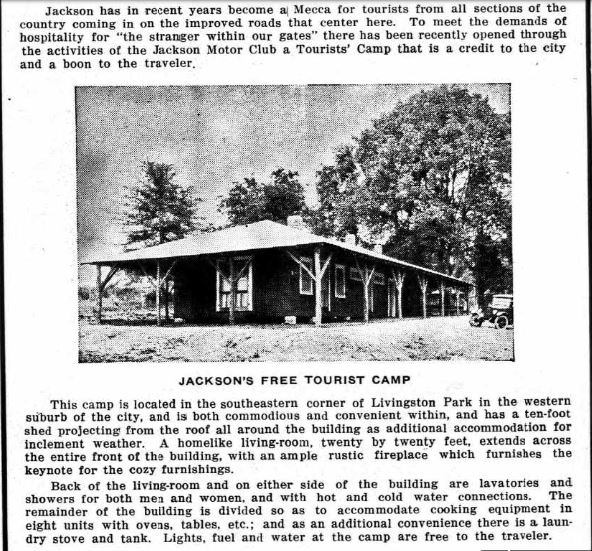It may seem impossible to believe today, but in the early days of automobile tourist travel, Jackon’s leaders (or some unnamed civic group, perhaps an automobile club) decided it would be a great idea to build a rustic cabin on West Capitol Street at the edge of Livingston Park and furnish it with stoves and bathrooms for up to eight families to stay overnight for free. We know this thanks to this photo and accompanying text in the very helpful booklet Jackson, Metropolis of Mississippi, published c.1924 by the Jackson Chamber of Commerce. Unfortunately, we don’t have an exact location of the tourist camp except for “southeastern corner of Livingston Park” because our Sanborn men didn’t record the structures at Livingston Park.
Does anyone know what happened to the building? I feel sure that it wasn’t in use for much more than a decade, with commercial automobile hotels like the Alamo and others opening in the 1930s and 1940s and offering better accomodations with more privacy and security. Anybody know of similar buildings anywhere else in the state?
Categories: Hotels, Jackson, Lost Mississippi



Your research and the articles you uncover show what a progressive and forward-thinking city Jackson was during the early and mid 20th century. What went wrong in the last 3 or 4 decades?
LikeLike
I think it’s easier for cities that are growing and getting richer to be more forward-thinking than cities whose populations have declined and are struggling to keep the water flowing and streets paved. Jackson is at the bottom slope (I hope) of a natural life cycle of cities, at least it seems natural in the U.S.–not sure elsewhere, and as a Jackson resident, I would resent this kind of accommodation as a waste of taxpayer dollars when I hit scores of potholes on my daily commute. I think too that back in the 1920s, cars were still a luxury item owned by the rich and the upper middle class, so this effort would have mostly benefited those classes of people, not necessarily the lower middle and working classes, who may have owned cars but probably didn’t get enough paid leave to go on such a vacation.
LikeLiked by 1 person
This is pretty amazing. I have never heard of such a thing, but then I was not motoring in 1924 either. Very interesting find!
LikeLike
I remember a similar, long, rustic style structure from my zoo service some 30 years ago. It had some modifications, but it was located along Capitol St just west of Parkins (?) Pharmacy and the Old Ladies Home. That would qualify for the southeast corner and would give easy access for travelers. It was used for storage at the time and in poor condition. Although we put several zoo structures like the elephant house and Monkey Island under a protective agreement, the subject building didn’t qualify. It was subsequently demolished.
LikeLike
-A Free Tourist Camp–Whites only-
LikeLike